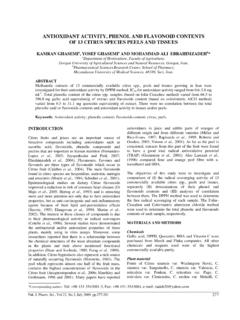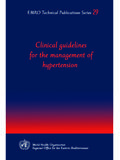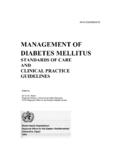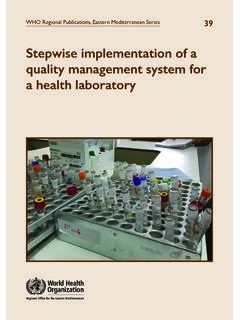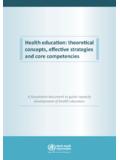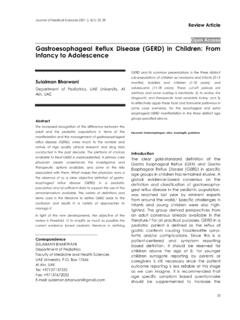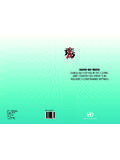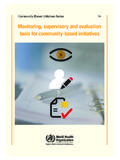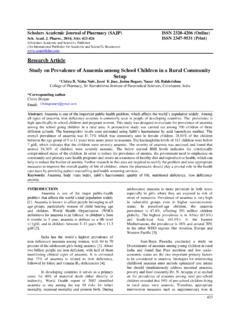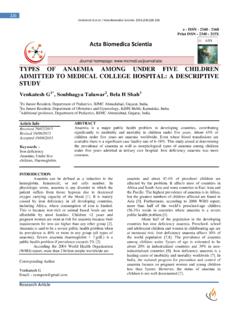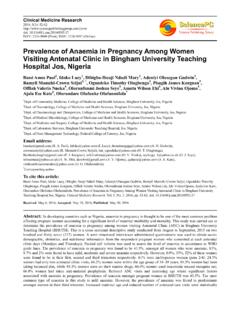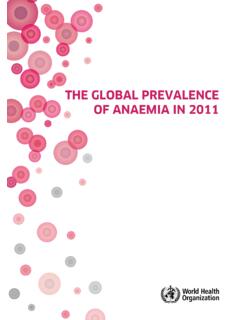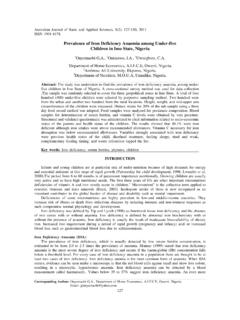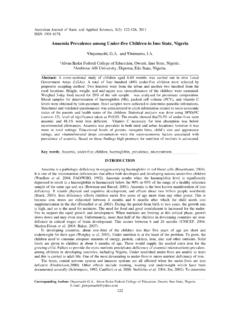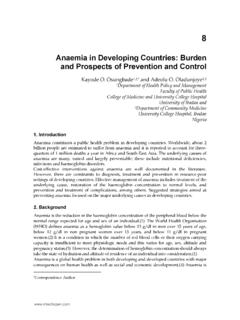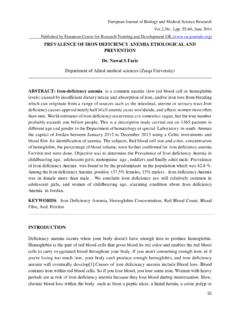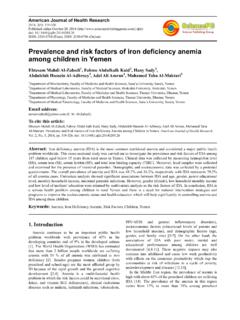Transcription of Prevalence of anaemia in preschool children in Karma ...
1 33 Prevalence of anaemia in preschool children in Karma Albalad area, Northern State, Hussein 1 and S. Mohamed 2 ABSTRACT anaemia is a major childhood health problem in developing countries. The aim of this cross-sectional study was to determine the Prevalence of anaemia , and some of its determinants, in preschool children in a rural village in the Northern State of Sudan. All children aged 3 6 years attending the 4 village kindergartens on the day of the study were enrolled. Demographic and socioeconomic data were collected using a questionnaire completed by parents, and blood samples were taken for haemoglobin measurement. Out of 163 children , 131 had anaemia (haemoglobin level < 11 g/dL), a Prevalence of This figure is comparable to data from other developing countries. The Prevalence of anaemia was not significantly associated with any of the studied demographic and socioeconomic factors (sex, economic status of the family, mother s literacy or family size) or health of the child (history of pica or number of attacks of malaria in the last year).
2 A campaign to tackle this serious health issue is urgently of Paediatrics, Dongola Police Hospital, Dongola, Sudan (Correspondence to Hussein: of Paediatrics, College of Medicine, King Saud University, Riyadh, Saudi : 23/04/13; accepted: 24/04/13 .. : .. 131 .. % ) 11 ( 163.)
3 ( ) ( ).. Pr valence de l an mie chez des enfants d ge pr scolaire dans la r gion de Karma Albalad dans l tat du Nord au SoudanR SUM L an mie chez l enfant est une pr occupation de sant publique majeure dans les pays en d veloppement. L objectif de la pr sente tude transversale tait de d terminer la pr valence de l an mie ainsi que certains de ses d terminants chez des enfants d ge pr scolaire dans un village rural de l tat du Nord du Soudan. Tous les enfants g s de trois six ans fr quentant les quatre coles maternelles du village le jour de l tude ont particip . Les donn es d mographiques et socio conomiques ont t recueillies l aide d un questionnaire rempli par les parents, et des chantillons de sang ont t pr lev s pour le dosage du taux d h moglobine.
4 Sur 163 enfants, 131 souffraient d an mie (taux d h moglobine < 11 g/dl), une pr valence de 80,4 %. Ce chiffre est comparable aux donn es d autres pays en d veloppement. La pr valence de l an mie n tait significativement associ e aucun des facteurs d mographiques et socio conomiques tudi s (sexe, statut socio conomique de la famille, degr d alphab tisme de la m re ou taille de la famille) ni la sant de l enfant (ant c dents de syndrome de pica ou nombre d pisodes de paludisme au cours de l ann e pr c dente). Une campagne pour s attaquer ce probl me de sant s rieux est n cessaire de toute Vol. 20 No. 1 2014 Eastern Mediterranean Health JournalLa Revue de Sant de la M diterran e orientale34 IntroductionAnaemia is a major child health prob-lem worldwide [1 3]. One-third of the world s population suffers from anaemia , notably over half of the children in developing countries [1].
5 Iron deficiency is the main cause of childhood anaemia ; other causes include micronutrient deficiencies, haemoglobinopathies and infections such as malaria [4 9]. children are more vulnerable to developing anae-mia because they are rapidly growing and liable to infection. Moreover, micronutrients such as iron and fo-lic acid are likely to be inadequate in children s diets if parents are not well informed [2,9,10,11]. anaemia is not only one of the leading causes of childhood mortality and morbidity [12], it may also affect cognitive de-velopment and school performance [13,14]. According to the World Health Organization (WHO), the Prevalence of anaemia , defined as haemoglobin (Hb) level < 11 g/dL, among children aged under 5 years in Africa varies from 49% to 89% [1]. To our knowl-edge, few studies have investigated the Prevalence of anaemia in Sudanese children [1,15 17] and there are no recent epidemiological studies.
6 Nev-ertheless it is likely that it continues to be a significant burden on health facili-ties in the country, as documented in a survey conducted in 2006, which estimated the Prevalence of anaemia in Sudanese children under 5 years old as [12,15]. There have been changes in recent decades in the demography and socioeconomic status of the Sudanese community, both negative due to civil wars and natural disasters (flooding and de-sertification), as well as positive due to Sudan became an oil-producing country. We therefore undertook this epidemiological study to determine the Prevalence of anaemia , and some of its determinants, in an area in the north of Sudan. This would help lo-cal health decision-makers to plan for prevention and comprehensive management of this important health problem [2,3,11].
7 MethodsStudy area and populationThe current study was conducted in Karma Albalad, which is a village in the Northern State of Sudan. It is located on the east bank of the River Nile, 60 km north of Dongola (the capital of the region). The population of the Northern State of Sudan is 750 000 according to the recent census, with the vast majority living in rural areas. About 10 000 people live in Karma Albalad, 800 of them in the age group 1 5 years according to Ministry of Health data from the expanded pro-gramme on immunization in North-ern State [12]. Most of the residents of the village are farmers, while a few are labourers, employees or working abroad [18]. The educational facilities include 4 kindergartens, 5 mixed pri-mary schools and 1 secondary school for girls. There is a health centre run by a medical assistant and a hospital with paediatric facilities in the nearby vil-lage of Alborgeig.
8 We selected Karma Albalad as the study area because it is the biggest and most populous village in the Northern State. Furthermore, there are 4 kindergarten schools in this village while the other villages have only 1 or preschool education is not mandatory in Sudan, it is strongly recommended by the Ministry of Education. All kindergartens in Karma Albalad are public, with admission free of charge for all children . The great ma-jority of parents admit their children to these kindergartens as it is widely be-lieved among the local community that kindergarten improves the academic and social performance in later school years. There are no available data on the number of preschool age children in the village. However, children at-tending kindergartens are fairly rep-resentative of the preschool age group as they account for about nearly 20% of the children aged < 5 years in the village [12].
9 Study design and sampleThis was a cross-sectional study. All children aged 3 6 years who at-tended the 4 kindergartens in Karma Albalad on the day of the study (8 January 2010) were included in the study group. Written consent was taken from the local authority as well as from the parents of children partici-pating in the study. Illiterate parents gave verbal consent to the research team members in the presence of a collectionThe study team included the first au-thor, 2 medical officers, 2 nurses and 2 laboratory technicians. The team members received training by the first author on the study technique. The first author also trained the kin-dergarten teachers on how to fill the questionnaire. The research team trained parents on how to fill the ques-tionnaire. The research team and the teachers assisted parents, especially illiterate ones, who had difficulty in completing the questionnaire.
10 Some of the parents who were comfortable with filling the questionnaire after the training session did so at home and returned it later. children whose par-ents refused to participate in the study or failed to fill the questionnaire were questionnaire was designed by the 2 authors and was pilot-tested on a group of school-age children not attending kindergarten to anticipate any problems in phrasing or under-standing of the questions by parents. It was in Arabic language, which is the 35 language spoken by the local com-munity. The questionnaire covered the demographic and socioeconomic status of the families. The first part of the questionnaire consisted of demographic information about the child (age, sex). The second part con-tained information about the parents (education, occupation, income).
